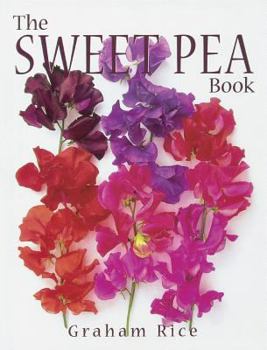The Sweet Pea Book
Select Format
Select Condition 
Book Overview
An inspiring and comprehensive guide, The Sweet Pea Book is for anyone interested in growing these most exquisite of fragrant flowers and using them in the garden. It covers the colorful history of the sweet pea, provides detailed practical advice on seed raising and cultivation, offers ideas for using the plants effectively in the garden, and discusses dwarf sweet peas for small gardens and patios. A comprehensive descriptive list of species and varieties will prove useful to all sweet pea enthusiasts.
Format:Paperback
Language:English
ISBN:0881925950
ISBN13:9780881925951
Release Date:July 2003
Publisher:Timber Press (OR)
Length:144 Pages
Weight:1.07 lbs.
Dimensions:0.5" x 6.9" x 9.8"
Customer Reviews
3 ratings
A beautiful find
Published by Thriftbooks.com User , 19 years ago
British author, Graham Rice has written 20 books on gardening subjects and is also a weekly columnist for London's "Evening Standard" newspaper. "The Sweet Pea Book" is a joy to read, and the photographs by judywhite (wife of Graham Rice) are among the finest I've seen in any book on horticulture. In Victorian times, the sweet pea was considered 'the queen of the annuals' but its popularity has since suffered a long decline, which this author means to reverse. He begins with the migration of the wild sweet pea ('Lathyrus odoratus') into the gardens of seventeenth-century Europe. There is still some debate as to where this migration occurred, but the sweet pea seems to have been first cultivated in Sicily, no matter where it had actually originated. According to this author, sweet peas are not difficult to grow. Depending on the climate (this book was written primarily for British and North American gardeners), they can be planted out in the spring or fall, or grown under glass. There are now dwarf varieties that lend themselves to container cultivation. He describes each variety or cultivar of modern sweet pea so that you can choose the ones that will do well in your garden--assuming you can find the seed for sale. (My favorite source is the Thompson & Morgan seed catalogue.) The author will help you decide whether to plant in spring or fall, whether to chip, sand, or soak your seed and how to keep the plants from getting too leggy (my biggest problem). There are also chapters on how to create new varieties of sweet pea, solving sweet problems, and which flowers mix very well with sweet peas. This is a delightful book to read even if you are not yet in love with the 'queen of annuals.' For those of us who are already fans, this book is a beautiful find.
A Great Guide to Sweet Peas
Published by Thriftbooks.com User , 20 years ago
For anyone wanting to grow sweet peas in their garden or just read up on the different types, this book is the way to go. Graham Rice creates a complete book about the history, types, fragrance and culture of the sweet pea. The photography is stunning. Rice gathers different varieties of sweet peas and photographs them together making this book full of color and beauty. Rice has done another great job by bringing these plants to us. It is impossible after reading this book that you won't want to try and grow sweet peas, even if you live in the tropics.
An excellent sweet pea resource!
Published by Thriftbooks.com User , 20 years ago
I am a lay gardener (as opposed to an educated horticulturalist) and my favorite smelling flower is the sweet pea. I grew one variety of them for the first time this spring and I am determined to grow more. I was looking for a book to educate me about sweet peas and this was the right book! This book is full of beautiful, colorful pictures which clearly show a flower's personality much more than a written paragraph could. I think this book is worth looking over just for the pictures alone. In addition, it is filled with helpful and information in an easy-to-read format. I particularly enjoyed the sections on growing sweet peas from seeds, sweet peas recommended for various regions of the United States (he includes info for those in the UK too), the history of the sweet pea, and the specific catalogue (with many pictures) of individual varieties and cultivars. I was grateful that he included a rating of each sweet pea's fragrance (if he knew it). That helped me find which sweet pea I wanted to get as a strong fragrance is an important feature for me. Kelly is definitely not a horticultural snob. He values the home gardener and encourages gardeners to dabble in crossing flowers and home breeding. He is very knowledgeable and suggests some potentially productive areas for experimenting. He also illuminates what type of breeding might be too difficult (needing a lab environment to succeed). His well-described `how to' section on breeding has inspired me to try it just for the adventure of it. I do wish more was said throughout the book about the specific temperatures that different types of sweet peas prefer. Also, I would find it more helpful if specific temperatures were given rather than just saying `hot summer' or `cold winter'. I also think it would be more helpful to only use the USDA zones as opposed to interspersing Sunset zones with the USDA zones. Other than that, this is a terrific book for home gardeners who just want to learn more about the sweet pea: it's history, how to grow it, and which sweet pea would be best for their Eden.





